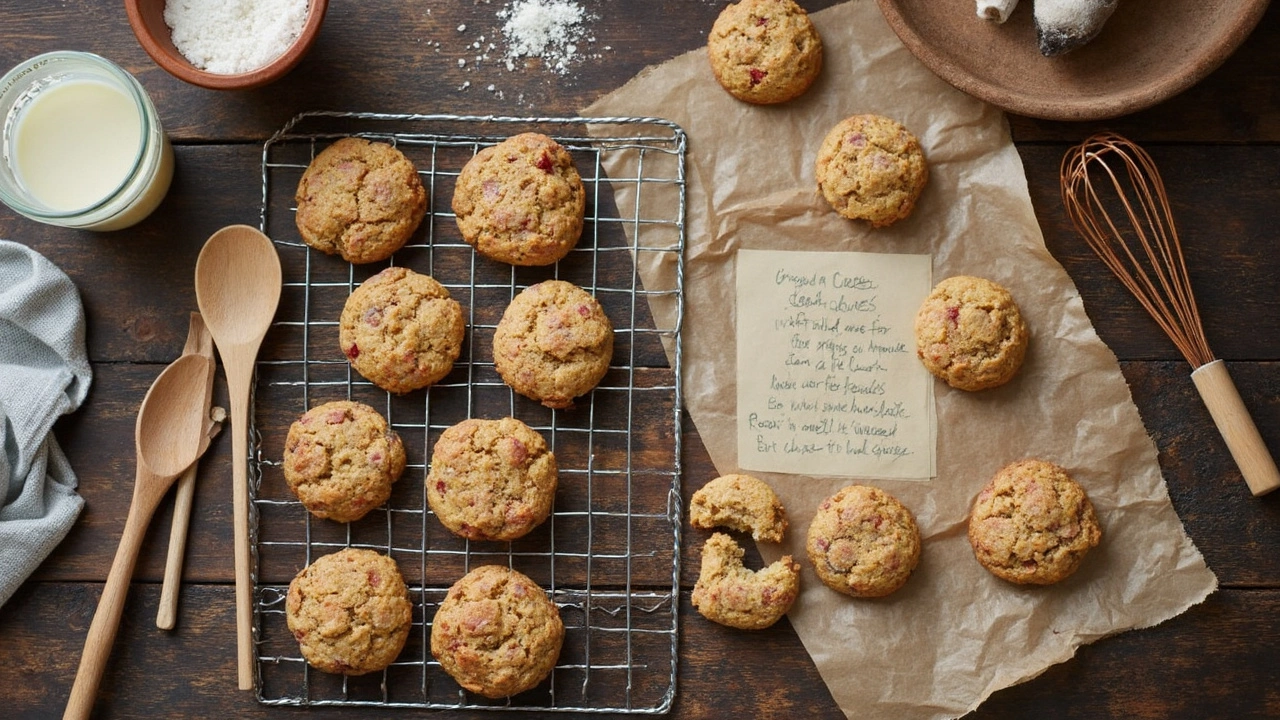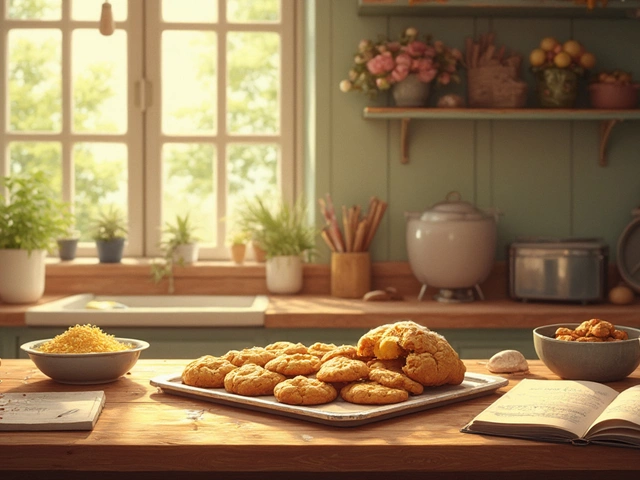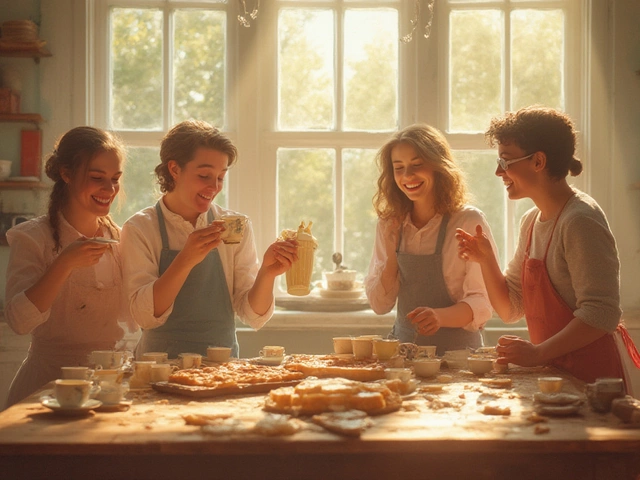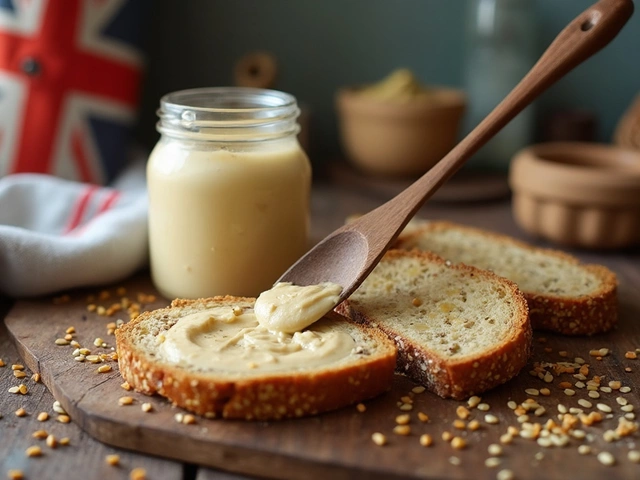
Cookies aren’t complicated, but there’s a reason the internet is packed with cookie recipes—people crave that warm, fresh-from-the-oven taste that the store-bought ones just can’t match. So what exactly is a cookie? Basically, it’s a small, sweet treat baked from a simple mix of flour, sugar, fat (like butter), and usually eggs. The magic comes from tossing these basics together and letting your oven do the heavy lifting.
Here’s the thing—anyone can bake cookies. You don’t need a stand mixer or fancy ingredients. In fact, some of the best cookies only call for a bowl, a spoon, and whatever you have in your pantry. You’ll run into recipes asking for things like baking soda, vanilla extract, and chocolate chips, but don’t let that scare you off. Most cookies follow the same basic steps, and you can play around with flavors once you get the hang of it.
One tip right off the bat: measure your ingredients! Baking isn’t like cooking where you can just throw things in. A little too much flour or sugar and you’re left with a tough or too-sweet cookie. Invest in some measuring cups if you don’t have them—they’ll make life way easier. Ready to dig into the details? Let’s go through what you need and how to get started making your own batch from scratch.
- What Are Cookies, Really?
- Essential Tools for Baking
- Key Ingredients Explained
- Step-by-Step: Your First Batch
- Common Mistakes and Fixes
- Tips to Make Every Cookie Awesome
What Are Cookies, Really?
Cookies are those sweet, bite-sized treats that almost everyone loves, and they go way back—people have been baking them for hundreds of years. At their core, cookies are made from flour, sugar, a type of fat (like butter or oil), and usually an egg or two. Most recipes add extras for flavor and texture, like vanilla, chocolate chips, or nuts, but the basic structure stays the same.
What makes a cookie different from cake or bread? It comes down to the ratio of ingredients. Cookies use less liquid and more fat, so you get a dough rather than a batter. That’s why cookies bake up firm on the outside, and often soft in the middle. The way different fats, sugars, and cooking times mix together decides whether you get a chewy, crispy, or cakey cookie.
- Homemade cookies are fresher and tastier than what you buy in a box, and you can make them your way, adding or swapping whatever you like.
- There are endless types—chocolate chip, oatmeal, snickerdoodle, peanut butter, sugar cookies, and way more. You’re not stuck with just one flavor.
- Cookies are super quick to bake compared to cakes or pies, and most batches are ready in under 30 minutes.
Ever wonder how Americans stack up against the rest of the world when it comes to cookies? Here’s a quick breakdown:
| Country | Most Popular Cookie | Average Eaten Per Year |
|---|---|---|
| USA | Chocolate Chip | Over 18,000,000,000 in total |
| UK | Digestive Biscuit | About 7,000,000,000 in total |
| Germany | Lebkuchen | Rises around holidays |
| China | Fortune Cookie | Mostly in restaurants |
So why are cookies so popular? For one thing, the smell of cookies baking is basically happiness in a kitchen. They’re easy to share, great for holidays or quick snacks, and the flavor options are endless. Once you know the basics, you can start inventing your own twist—maybe swapping chocolate for white chocolate, or adding pretzels for crunch. That’s the real fun of baking cookies at home.
Essential Tools for Baking
Baking homemade cookies doesn’t mean turning your kitchen into a professional bakery. You only need a handful of basic tools to get started, and you probably own a few already. No need to buy gadgets you’ll never use—just cover the basics for a stress-free cookie experience.
Here’s what actually matters for beginners:
- Mixing bowls: At least two. You’ll need one for dry ingredients and one for wet. Glass or metal bowls are best, but plastic works fine.
- Measuring cups and spoons: Accurate measurements make or break your dough. A set with both dry and liquid cups is super handy.
- Baking sheet: A rimless, flat sheet lets cookies spread and brown evenly. Lined with parchment paper or a silicone mat, cleanup is a breeze.
- Spoon or spatula: For mixing your dough, you don’t need electric beaters—just elbow grease and a sturdy spoon or spatula.
- Cooling rack: Sets your cookies up for perfect texture. Cooling on a rack stops the bottoms from getting soggy.
If you want to be fancy, a cookie scoop gives you even portions and picture-perfect cookies, but regular spoons work fine.
Just to give you an idea, here’s a breakdown of what most home bakers use when making cookies:
| Tool | Most Common Material | Do You Really Need It? |
|---|---|---|
| Mixing Bowls | Glass/Metal | Yes |
| Measuring Cups/Spoons | Plastic/Metal | Yes |
| Baking Sheet | Aluminum | Yes |
| Cooling Rack | Chrome/Steel | Helpful |
| Cookie Scoop | Stainless Steel | Optional |
| Parchment/Silicone Mat | Parchment/Silicone | Helpful |
Skip the stand mixer for now. Most classic cookies just need basic tools and a little patience. Keep it simple—you’ll probably have your first batch in the oven before you know it.
Key Ingredients Explained
The secret to great homemade cookies is understanding what each main ingredient does. Mess up one part, and you get flat pancakes or tough little bricks instead of a chewy delight. Here’s what actually matters and why.
Flour is the backbone. Most cookies use all-purpose flour. It gives your cookies structure. Too much flour, though, and you’ll end up with a dry, cakey bite. For most US recipes, start with about 1 cup (120g) per batch — measure it loosely, don’t pack it down. If you swap in whole wheat, expect things to get denser.
Fat makes cookies taste rich and gives them that dreamy texture. Butter is king for flavor, but you can use margarine or vegetable shortening too. Butter will give more flavor and a bit of crisp. Oil works, but cookies might spread too much or go greasy. If a recipe says to use unsalted butter, it’s so you can control the salt yourself.
Sugar isn’t just for sweetness. White sugar makes cookies crisp and golden; brown sugar brings moisture and chew. Lots of classic cookies use both for balance. Brown sugar contains molasses, so it’ll also add a caramel vibe. On average, a batch might need about 1/2 cup each.
Eggs bind everything together and add moisture. Stick with large eggs unless the recipe says otherwise. If you skip eggs (maybe allergies?), cookies get crumbly—try unsweetened applesauce as a swap.
Then come the extras:
- Baking Soda or Baking Powder: These make cookies rise and spread. Baking soda gives darker browning. Most chocolate chip cookies use 1/2 teaspoon baking soda per batch.
- Salt: Don’t forget it. Even sweet cookies need a little—usually 1/4 to 1/2 teaspoon. It makes the other flavors pop.
- Mix-ins: Chocolate chips, nuts, coconut, dried fruit—these are just for fun. 1 cup of mix-ins is a safe place to start.
- Flavor boosters: Pure vanilla extract is the MVP, usually 1-2 teaspoons. Almond extract, cinnamon, or citrus zest can level things up.
Here’s a snapshot of how the basic ingredients affect your cookies:
| Ingredient | Main Function | What Happens If You Use Too Much? |
|---|---|---|
| Flour | Structure | Dry, crumbly cookie |
| Sugar | Sweetness, chew, crispness | Spreads too much or tastes too sweet |
| Butter | Richness, flavor | Spreads too much, greasy texture |
| Eggs | Bind, moisture | Rubbery or cakey |
| Baking soda/powder | Lift, browning | Strange flavor, too puffy |
As Joy Wilson from Joy the Baker puts it,
"The magic of a great cookie is all about balance — the right sugar, flour, and fat ratio makes the difference between perfection and disappointment."Don’t be afraid to experiment once you get a feel for the basics. Switch up flavors, but stick to the measurements for the must-have ingredients.

Step-by-Step: Your First Batch
Baking your first batch of homemade cookies doesn't have to be stressful. Here’s how to get it done, even if you’ve never touched an oven before. We’ll go through a classic chocolate chip cookie recipe because, let’s be real, it’s the crowd favorite.
Before you begin, grab these basic ingredients:
- 1 cup (226g) butter (softened)
- 1 cup (200g) white sugar
- 1 cup (220g) brown sugar
- 2 eggs
- 2 tsp vanilla extract
- 3 cups (360g) all-purpose flour
- 1 tsp baking soda
- 0.5 tsp salt
- 2 cups (340g) chocolate chips
Here’s what to do:
- Preheat your oven to 350°F (175°C). Line two baking sheets with parchment paper. This prevents sticking and makes clean-up much easier.
- Mix the butter, white sugar, and brown sugar in a big bowl. Stir until creamy—if you have a hand mixer, great. If not, use those arms!
- Add in the eggs, one at a time, then get that vanilla in there. Mix until it’s all smooth.
- In a separate bowl, mix the flour, baking soda, and salt. Then, slowly add this into your wet mix. Don’t dump it in at once or you’ll have flour flying everywhere.
- Now, fold in the chocolate chips. Don’t overmix or your cookies will be tough.
- Scoop tablespoon-sized balls of dough onto your lined baking sheets. Space them out—cookies spread as they bake.
- Bake for 10–12 minutes until the edges turn light golden brown. They might look a bit soft in the middle, but that’s perfect. They’ll firm up as they cool.
- Let them cool on the tray for five minutes, then switch to a wire rack if you have one. That stops them from getting soggy bottoms.
The great thing? You can freeze raw dough balls for fresh, hot cookies anytime. Just bake straight from the freezer—add an extra two minutes in the oven.
Here’s a little cheat sheet for baking temperatures and times if you swap ingredients or cookie styles:
| Cookie Type | Oven Temp (°F) | Bake Time (min) |
|---|---|---|
| Standard chocolate chip | 350 | 10–12 |
| Thick oatmeal cookie | 350 | 12–14 |
| Peanut butter cookie | 325 | 12–15 |
| Shortbread | 300 | 18–20 |
One more pro tip: If you want perfectly round cookies, use an ice cream scoop for dough. It’s easy, less mess, and your batch will look like you bought them from a bakery.
Common Mistakes and Fixes
Even longtime bakers mess up sometimes, so if your homemade cookies aren’t perfect the first time, don’t stress. These are the top cookie mistakes new bakers make—and how to fix them for your next round.
- Cookies Spread Too Much: Warm butter is the usual culprit. Always chill your dough if the recipe asks, and make sure your baking sheet isn’t hot from a previous batch.
- Cookies Don’t Spread At All: Too much flour will do this. Spoon flour into your measuring cup and level it off—don’t scoop straight from the bag. This way, you won’t pack in extra flour by accident.
- Cookies Come Out Hard or Dry: Overbaking is usually the reason. Take cookies out when the edges are set, even if the centers look soft. They finish setting up on the sheet outside the oven.
- Cookies Burn on the Bottom: Dark or thin baking sheets bake faster and can cause burning. Try using a lighter-colored pan or baking parchment. Also, bake one tray at a time in the center of the oven.
- Uneven Cookies: Different sizes or heights on the tray means some will burn while others stay raw. Use a cookie scoop for even portions, or roll balls the same size by hand.
Here’s a quick cheat sheet with why most beginner mistakes happen and how to solve them. Keep it close the next time you bake!
| Problem | Cause | Fix |
|---|---|---|
| Flat, greasy cookies | Warm dough or too much butter | Chill dough, measure butter correctly |
| Dry, crumbly cookies | Overbaked or too much flour | Bake less time, measure flour lightly |
| Uneven results | Tray too crowded | Leave space between dough balls |
| Burnt bottoms | Oven too hot or thin tray | Lower oven temp, use thicker tray, use parchment |
Pop your cookies off the tray as soon as they’ve cooled for a couple of minutes—this keeps them from overbaking on the hot pan. If you want extra soft cookies, store them with a slice of bread in the container. The cookies soak up the moisture and stay chewy way longer.
Tips to Make Every Cookie Awesome
If you want your homemade cookies to taste like something out of a bakery, a few tried-and-true hacks make a huge difference. Some of these are little tweaks, but they have a big impact on flavor, texture, and even looks.
- Chill your dough. Most cookie recipes get way better if you let the dough rest in the fridge for at least 30 minutes. This stops cookies from spreading too thin and makes the flavor richer. Restaurants and bakeries sometimes chill their dough overnight.
- Don’t over-mix. When you add flour, just stir until it’s barely combined. Over-mixing leads to hard, tough cookies. This is a classic rookie mistake.
- Use real butter. Skip margarine or butter substitutes. Actual butter gives better taste, texture, and the right kind of chew.
- Line your tray. Use parchment paper or a silicone baking mat. This keeps cookies from sticking and helps them cook evenly.
- Test your oven. Most ovens run hot or cold. A cheap oven thermometer keeps you honest. If your cookies burn even when you follow every step, your oven might be the culprit.
- Rotate trays halfway through baking. Home ovens are rarely even. Spin your baking sheet around so cookies cook the same on all sides.
- Let cookies set on the tray. Take them out when they look just golden. Cookies keep cooking on the hot tray for a few minutes, so don’t wait until they’re fully firm in the oven, or you’ll get rocks.
A lot of bakers wonder how ingredients and baking times affect the final cookie. Here’s a handy table that sums up what different tweaks do to your cookies. Save this for your next batch—seriously, it makes a difference!
| Adjustment | Result |
|---|---|
| More brown sugar | Chews up softer, moister cookies |
| More white sugar | Crisps up and spreads more |
| Chilled dough | Thicker, more flavorful cookies |
| Shorter bake time | Soft and gooey center |
| Longer bake time | Crispy and browned edges |
| Adding an extra egg yolk | Super chewy texture |
Don’t be afraid to experiment—switch up the mix-ins (like swapping chocolate chips for nuts or dried fruit) once you’ve nailed the basics. And remember, most brand-name cookie recipes (think Nestle Toll House) got popular because they’re simple and reliable, not because they’re full of weird ingredients. Stick to the basics and your cookies will always turn out crowd-pleasing.












Write a comment